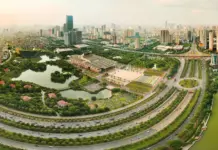Q: How do you assess about the preservation of Thang Long Imperial Citadel since this special relic site was recognised as a world cultural heritage by the UNESCO?
A: The preservation of the world cultural heritage Thang Long Imperial Citadel will be implemented for a long time into the future because this heritage mainly consists of archaeological relics. It means that they are conserved underground. Moreover, the scale of the relic site is very large. Meanwhile, there have not been any in-situ or outdoor conservation projects in the country, the experience for this work is zero and resources are considered to be starting from zero.
Since its discovery in 2002, the in-situ preservation of Thang Long Imperial Citadel has always belonged to archaeologists. They are excavators who clearly understand the relic, so they had to carry out the urgent work of immediately conserving it to measure, draw, photograph, statistic, describe, compare, identify, date and assess initial values. When a policy on the site’s conservation was released, they continued to boost the preservation efforts.
In general, the urgent task of preserving the Thang Long Imperial Citadel has achieved a very basic victory: preserving the relics following excavation. However, in the long-term, it is crucial to have an urgent on-site conservation project for the Thang Long Imperial Citadel heritage, towards the goal of sustainable and modern conservation and enhancement of attractions for the public. This project was included in the Government’s planning as well as the ideas of managers and scientists. However, the on-site conservation is still too new, so the construction of a roof to preserve the relic site in 18 Hoang Dieu Street is still in the plan. I think that this must be completed in the future.
Q: Thang Long Imperial Citadel is considered as an archaeological heritage with a special lucky fate; meanwhile, the recognition and behavior to others are assessed unsuitable. What do you think about this?
A: Thang Long Imperial Citadel has a special lucky fate; however, it must be clear that that luck was achieved after an extremely arduous and difficult journey of scientists and culturalists nationwide. The wisdom of the Party, National Assembly, and Government in the year 2003-2004 has conserved this priceless heritage.
Speaking at a conference on safeguarding Vietnamese cultural heritages held by Ministry of Culture, Sports and Tourism on July 27, 2018, Prime Minister Nguyen Xuan Phuc emphasised that it is essential to thoroughly grasp the spirit that anything can be built, produced and composed but the heritage cannot be created. Therefore, the heritages absolutely must not be destroyed for any purpose, he added.
However, I have seen no relevant management agencies at any level focusing on the development of archaeological planning which has been mentioned on papers over dozens of years. The Vietnam Archeology Association and I have spoken out to the public on many occasions that over 90% of the archaeological relics dating back to Hung Kings period in Phu Tho Province have been wiped out. If no urgent measures are taken, the remaining percentage of the relics will soon disappear. As a result, there would not be any relic sites as authentic evidence of the glorious period of our ancestors who built the country. The Vietnam Archeology Association is expected to continue to propose the measures on protecting the archaeological relic sites to relevant agencies.
Q: Archaeological heritage is still considered marginal and disappearing rapidly in the face of development. In your opinion, what should we do to protect and change the behaviour to these fragile heritages?
A: The UNESCO has issued its specific chapters and conventions on archeology because they recognise that these heritages are very important and related to the history, culture and life humanity from its origins to modern life, but with fragile fates. Only a small level of activity of humanity or a small fluctuation of nature can cause the relics to permanently disappear. Meanwhile, the number of relics remaining is extremely small.
Therefore, the join efforts made by the whole cultural management system, from the central to local levels, are necessary for the protection of archaeological relic sites, based on the strict implementation of the Law on Cultural Heritage and the management agencies’ decrees and circulars. It is urgent to build an archaeological plan to make effective solutions for the protection and preservation of these relics in the long term. We can learn experience from several countries in the region such as China, Japan and Republic of Korea. In these countries, the conservation of archaeological heritages was placed under strict laws that all people and agencies are required to seriously implement. The preservation of archaeological heritages is combined harmoniously with the national construction and development. The relevant agencies should pay more synchronous attention to archaeology. These actions are seemingly simple but extremely difficult. However, we must try hard to protect the remaining relic sites.
Thank you very much for your interview!



